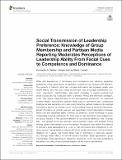Files in this item
Social transmission of leadership preference : knowledge of group membership and partisan media reporting moderates perceptions of leadership ability from facial cues to competence and dominance
Item metadata
| dc.contributor.author | Watkins, Christopher D. | |
| dc.contributor.author | Xiao, Dengke | |
| dc.contributor.author | Perrett, David I. | |
| dc.date.accessioned | 2020-01-21T12:30:12Z | |
| dc.date.available | 2020-01-21T12:30:12Z | |
| dc.date.issued | 2020-01-14 | |
| dc.identifier | 265896007 | |
| dc.identifier | 9a8fc76f-8758-43e9-a6ec-edabefecfbb5 | |
| dc.identifier | 85078797636 | |
| dc.identifier | 000509904900001 | |
| dc.identifier.citation | Watkins , C D , Xiao , D & Perrett , D I 2020 , ' Social transmission of leadership preference : knowledge of group membership and partisan media reporting moderates perceptions of leadership ability from facial cues to competence and dominance ' , Frontiers in Psychology , vol. 10 , 2996 . https://doi.org/10.3389/fpsyg.2019.02996 | en |
| dc.identifier.issn | 1664-1078 | |
| dc.identifier.other | RIS: urn:A7039456327B276F917E38E4D08918B5 | |
| dc.identifier.other | ORCID: /0000-0002-6025-0939/work/67919477 | |
| dc.identifier.uri | https://hdl.handle.net/10023/19324 | |
| dc.description.abstract | While first impressions of dominance and competence can influence leadership preference, social transmission of leadership preference has received little attention. The capacity to transmit, store and compute information has increased greatly over recent history, and the new media environment may encourage partisanship (i.e., “echo chambers”), misinformation and rumor spreading to support political and social causes and be conducive both to emotive writing and emotional contagion, which may shape voting behavior. In our pre-registered experiment, we examined whether implicit associations between facial cues to dominance and competence (intelligence) and leadership ability are strengthened by partisan media and knowledge that leaders support or oppose us on a socio-political issue of personal importance. Social information, in general, reduced well-established implicit associations between facial cues and leadership ability. However, as predicted, social knowledge of group membership reduced preferences for facial cues to high dominance and intelligence in out-group leaders. In the opposite-direction to our original prediction, this “in-group bias” was greater under less partisan versus partisan media, with partisan writing eliciting greater state anxiety across the sample. Partisanship also altered the salience of women’s facial appearance (i.e., cues to high dominance and intelligence) in out-group versus in-group leaders. Independent of the media environment, men and women displayed an in-group bias toward facial cues of dominance in same-sex leaders. Our findings reveal effects of minimal social information (facial appearance, group membership, media reporting) on leadership judgments, which may have implications for patterns of voting or socio-political behavior at the local or national level. | |
| dc.format.extent | 9 | |
| dc.format.extent | 1213325 | |
| dc.language.iso | eng | |
| dc.relation.ispartof | Frontiers in Psychology | en |
| dc.subject | Face perception | en |
| dc.subject | Leadership | en |
| dc.subject | Dominance | en |
| dc.subject | Intelligence | en |
| dc.subject | Priming | en |
| dc.subject | BF Psychology | en |
| dc.subject | DAS | en |
| dc.subject.lcc | BF | en |
| dc.title | Social transmission of leadership preference : knowledge of group membership and partisan media reporting moderates perceptions of leadership ability from facial cues to competence and dominance | en |
| dc.type | Journal article | en |
| dc.contributor.institution | University of St Andrews. School of Psychology and Neuroscience | en |
| dc.contributor.institution | University of St Andrews. Institute of Behavioural and Neural Sciences | en |
| dc.contributor.institution | University of St Andrews. Centre for Social Learning & Cognitive Evolution | en |
| dc.identifier.doi | 10.3389/fpsyg.2019.02996 | |
| dc.description.status | Peer reviewed | en |
This item appears in the following Collection(s)
Items in the St Andrews Research Repository are protected by copyright, with all rights reserved, unless otherwise indicated.

